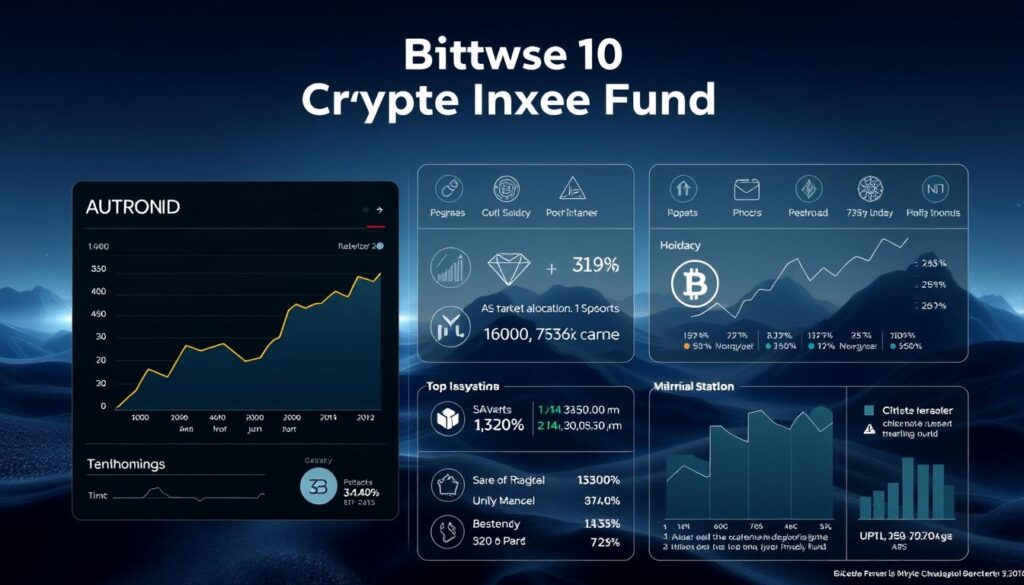Now Reading: Diversify with Cryptocurrency Index Fund Diversified Investment
- 01
Diversify with Cryptocurrency Index Fund Diversified Investment
Diversify with Cryptocurrency Index Fund Diversified Investment

The digital asset landscape can be overwhelming for many people. Individual tokens often experience extreme price movements that challenge even experienced traders. This volatility makes smart portfolio construction essential for long-term success.
Many are now turning to structured approaches that mirror traditional finance principles. These methods offer exposure to multiple digital assets through a single vehicle. This approach reduces the complexity of managing separate positions.
The growing popularity of crypto baskets reflects this shift in strategy. Investors seek products that provide broad market coverage while minimizing risk. This guide will explore how these tools work and their benefits.
We’ll examine performance metrics, underlying holdings, and risk management considerations. You’ll gain insights into regulatory aspects and selection criteria. Our goal is to help you make informed decisions about your digital asset allocation.
Key Takeaways
- Digital asset markets are highly volatile, making diversification crucial
- Structured products offer exposure to multiple cryptocurrencies at once
- Single-vehicle approaches simplify portfolio management
- These tools bring traditional finance principles to digital assets
- Understanding holdings and risk management is essential
- Regulatory considerations play an important role in selection
- Informed decisions require comprehensive market knowledge
Understanding Cryptocurrency Index Funds
The emergence of basket-style products has simplified access to multiple digital tokens. These collective vehicles pool resources from various participants to create broad market exposure.
What is a Cryptocurrency Index Fund?
This financial vehicle operates as a pooled instrument holding various digital currencies. Unlike actively managed mutual funds, it follows a passive strategy tracking specific market benchmarks.
The approach results in lower management fees through reduced expense ratios. This cost efficiency makes long-term participation more accessible to mainstream investors.
| Feature | Crypto Index Fund | Stock Index Fund | Bond Index Fund |
|---|---|---|---|
| Primary Assets | Digital currencies | Company shares | Debt instruments |
| Volatility Level | High | Medium | Low |
| Management Style | Passive | Passive | Passive |
| Potential Returns | Variable | Historical average | Fixed income |
The Evolution of Crypto Indexing
The concept has matured from theoretical frameworks to practical institutional offerings. Early adopters paved the way for today’s sophisticated tracking methodologies.
Market infrastructure improvements enabled more reliable index construction. This progression reflects the digital asset space’s ongoing integration with traditional finance principles.
Market Performance and Fund Holdings
The performance metrics of a leading basket fund offer a clear picture of its market behavior. Analyzing this data helps investors understand its value proposition.
It shows how a collection of digital assets performs compared to single tokens. This analysis is vital for making informed decisions.
Key Performance Metrics and Data Points
As of late October 2025, the Bitwise 10 basket shows a market price of $75.11. Its Net Asset Value (NAV) is slightly higher at $76.71.
This small difference is common in trading. The fund manages over $1.55 billion in assets.
Recent monthly returns were negative, showing short-term volatility. However, long-term performance is strong.
Since its start, the NAV has gained over 660%. This highlights the potential of a patient approach.
Past performance does not guarantee future results. The market remains unpredictable.
Overview of Fund Holdings and Asset Allocation
The fund’s holdings are concentrated in major digital assets. Bitcoin makes up 73.5% of the portfolio.
Ethereum follows with a 15.8% allocation. This creates a core focused on the largest, most established tokens.
Smaller allocations include XRP, Solana, and Cardano. This mix balances focus with diversification.
For those comparing options, researching the best crypto indices to buy is a wise step. It provides broader context for your strategy.
Inside the Bitwise 10 Crypto Index Fund
The Bitwise 10 Crypto Index Fund provides a concrete example of how these structured products function in practice. Its operational details offer transparency for potential participants.
Fund Details, NAV, and AUM Insights
This vehicle trades under the ticker BITW and launched on November 22, 2017. It holds over $1.55 billion in assets, showing significant market scale.
There are more than 20 million shares available for trading. The annual expense ratio is 2.5%. This fee covers management, secure custody, and administrative services.
Coinbase Custody holds the underlying assets, providing institutional-grade security. Tax reporting is handled via Schedule K-1, which is different from standard stock forms.

Index Methodology and Active Monitoring
The fund follows a strict, rules-based methodology. It tracks the Bitwise 10 Large Cap Crypto Index.
The portfolio is rebalanced monthly. This process ensures it holds the most valuable and liquid assets. Eligibility criteria focus on security, regulatory status, and market representation.
A dedicated team provides 24/7 monitoring for sudden market events. An expert Index Advisory Board, including figures from Blockchain Capital and Bloomberg, guides the methodology. This ensures a robust and disciplined approach for investors.
Cryptocurrency index fund diversified investment: A Diversification Strategy
Effective exposure to digital markets involves balancing potential returns with careful risk assessment. This strategic approach helps manage the inherent volatility of individual tokens.

A well-constructed portfolio spreads capital across multiple digital assets. This method reduces dependence on any single token’s performance.
Benefits of a Diversified Crypto Portfolio
Diversification works similarly in digital markets as traditional finance. However, crypto assets have unique risk characteristics.
Spreading your investment across various tokens minimizes concentration risk. If one project underperforms, others may balance the impact.
Digital currencies like bitcoin show low correlation to traditional equities. The 10-year correlation between bitcoin and the S&P 500 is only 0.15.
This makes crypto exposure valuable for broader portfolio construction. Systematic rebalancing maintains target allocations during price swings.
While diversification reduces specific token risks, market-wide factors remain. This approach is one component of comprehensive risk management.
Alternative Investment Strategies for a Volatile Market
When conventional asset classes move in sync during downturns, investors need alternative approaches. The 2022-2024 period revealed significant limitations in traditional portfolio construction.

During this challenging timeframe, both the Bloomberg Aggregate Bond Index and S&P 500 declined in 14 separate months. This breakdown of traditional diversification forced a reevaluation of risk management strategies.
Comparing Traditional Assets with Alternatives
Alternative strategies demonstrated resilience when traditional stocks and bonds faltered. Funds like BlackRock’s Global Equity Market Neutral approach generated returns without market beta exposure to equities.
Tactical allocation vehicles dynamically shift exposure across various asset classes. They achieve growth with low correlation to conventional holdings.
Sophisticated investors screen alternatives using specific criteria. They analyze correlation versus traditional assets, particularly stocks that drive portfolio volatility.
They also evaluate consistent rolling returns exceeding cash and favorable risk-adjusted profiles. These metrics help identify strategies that can provide ballast during market stress.
Digital assets like bitcoin have shown compelling diversification characteristics. With a 10-year correlation of just 0.15 to the S&P 500, they offer unique portfolio benefits alongside other alternative approaches.
DIY vs. Traditional Cryptocurrency Index Funds
The pursuit of a diversified digital asset portfolio presents two distinct paths. Each has its own set of trade-offs between control, cost, and convenience.
Understanding these differences helps you choose the right strategy for your goals.
Advantages of Building Your Own Index Fund
Creating your own basket of digital assets starts with opening an account on a trusted exchange. You then select which cryptocurrencies to include and decide their allocation percentages.
The main benefit is avoiding annual fees, like the 2.5% expense ratio some funds charge. This cost saving can be significant over time.
You also gain complete control over your holdings. This allows for custom strategies and personal conviction in your picks.

Expense Ratios and Trading Fees Considerations
While you skip the management fees, trading on an exchange still incurs costs. Each purchase and rebalancing transaction has a fee.
Managing a personal portfolio demands a considerable time commitment. Research, execution, and monitoring can be complex.
Rebalancing many holdings during volatile markets is challenging. This makes the DIY approach difficult for large, complex portfolios.
| Feature | DIY Portfolio | Traditional Fund |
|---|---|---|
| Annual Expense Ratio | $0 | 2.5% (example) |
| Trading Fees | Per transaction | Included in expense ratio |
| Time Commitment | High (Research & Execution) | Low (Hands-off) |
| Control Over Holdings | Full customization | Follows set methodology |
| Best For | Hands-on, cost-conscious investors | Those valuing convenience and professional management |
The choice depends on your investing style, technical skill, and available time. Weighing control against convenience is key.
Risk Management and Tax Implications
Managing digital asset exposure requires careful attention to both portfolio protection and tax obligations. These two areas present unique challenges that demand proactive strategies.
Understanding these factors helps investors make informed decisions about their participation level.
Mitigating Investment Risk in Crypto Markets
Digital assets experience dramatic price swings that exceed traditional market movements. This volatility creates both opportunity and significant risk for participants.
Position sizing becomes crucial for managing exposure. Limiting your allocation to an appropriate percentage of total assets helps control potential losses.
Longer time horizons allow portfolios to recover from short-term volatility. Historical data provides valuable information about typical recovery periods.
Diversification across different asset classes further reduces overall portfolio risk. This approach balances potential returns with prudent protection strategies.
Understanding Tax Rules and Compliance
Tax reporting for digital asset vehicles differs significantly from traditional investment forms. The Bitwise 10 vehicle uses Schedule K-1 instead of standard 1099 forms.
This partnership taxation method requires additional understanding. Each rebalancing activity within the fund may create taxable events.
Consulting tax professionals familiar with digital asset rules is highly recommended. Proper compliance ensures you maximize your investment value while meeting all obligations.
The administrative aspect adds complexity to digital asset ownership. However, proper planning makes this manageable for most investors.
Regulatory and Operational Considerations
Understanding the legal structure behind publicly traded crypto baskets helps investors assess their protections. These products operate within specific regulatory frameworks that differ from traditional offerings.
The operational backbone involves multiple specialized service providers. Each plays a critical role in maintaining compliance and security.
SEC Registration and Fund Compliance
Shares of the Bitwise 10 vehicle are registered with the SEC under Section 12(g). This provides regulatory oversight for investor protection.
However, these shares lack registration under the Securities Act of 1933. They also aren’t covered by the Investment Company Act of 1940.
This creates a different regulatory framework than traditional mutual funds. Investors should understand these distinctions when evaluating options.
The fund doesn’t operate a redemption program. Shares must be sold on the secondary market, which may affect pricing.
Operational partners include Coinbase Custody for asset security. Theorem Fund Services handles administration, while KPMG provides audit services.
American Stock Transfer & Trust Company manages share ownership records. This ensures accurate information about who holds shares.
Anyone with a brokerage account can purchase shares on OTCQX. This accessibility makes the product available to mainstream investors without accreditation requirements.
Future Trends and Expert Insights
Industry leaders are shaping the next generation of digital asset portfolio tools. The Bitwise advisory board includes financial veterans like Spencer Bogart from Blockchain Capital and Srikant Dash from Bloomberg. Their expertise guides product development toward more sophisticated offerings.
Emerging Trends in Crypto Indexing
Traditional financial companies are launching vehicles that provide digital asset exposure. This institutional adoption may lead to more diverse product offerings. Different strategies and risk profiles will cater to various target markets.
Technological trends include developing more sophisticated methodologies. Future approaches may incorporate factors beyond market capitalization. Network activity and development metrics could influence weighting decisions.
Expert Opinions and Market Predictions
Matt Hougan’s ETF knowledge informs predictions about regulatory evolution. Full Investment Company Act registration could enable new ETF structures. This would improve liquidity and reduce pricing discrepancies.
Market data shows compelling performance characteristics. Bitcoin’s 10-year correlation with the S&P 500 remains low at 0.15. This makes digital assets valuable for portfolio diversification beyond traditional stocks and bonds.
Experts suggest alternatives including crypto exposure may play critical roles. In environments of persistent inflation, investors seek “cash plus” returns. Strategies with lower correlations to equities gain importance for balanced portfolio construction.
Conclusion
Building a resilient portfolio in today’s financial landscape involves exploring modern alternatives. Crypto index funds offer a structured approach to digital asset exposure.
These vehicles provide instant diversification across major tokens through a single investment. This simplifies the process of investing in digital markets.
Understanding the methodology behind each index is crucial for informed decisions. Investors should evaluate fees, holdings, and risk management strategies.
The choice between professional management and DIY approaches depends on individual goals. Both paths offer unique advantages for different types of investors.
As the cryptocurrency space evolves, these funds continue to mature. They represent an accessible entry point for portfolio diversification.
Successful investing in this space requires patience and thorough research. Always align your strategy with personal risk tolerance and long-term objectives.
FAQ
What is a crypto index fund?
A crypto index fund is a managed portfolio that tracks a specific market benchmark. It provides broad exposure to the top digital assets, like Bitcoin and Ethereum, in a single purchase. This simplifies gaining access to the market without buying each asset individually.
How does a crypto index fund help with diversification?
These funds spread your capital across multiple digital assets. This strategy helps reduce the impact if one asset’s price drops significantly. It’s a core principle of managing risk while participating in the potential growth of the overall market.
What are the typical fees associated with these funds?
The primary fee is the expense ratio, which covers management and operational costs. It’s crucial to compare this ratio between different options, as lower fees can significantly improve your net returns over time. Some platforms may also charge trading fees.
How is the value of my shares calculated?
The value is based on the fund’s Net Asset Value (NAV). The NAV is calculated using the real-time prices of all the assets held within the fund’s portfolio. This ensures your shares reflect the current market value of the underlying holdings.
Are crypto index funds regulated like mutual funds or ETFs?
Regulation varies. Some funds, like the Bitwise 10 Crypto Index Fund, are SEC-reporting companies, providing a layer of transparency and oversight. However, the regulatory landscape is still evolving, so it’s important to research a fund’s specific compliance status.
What are the tax implications of investing in a crypto index fund?
In the United States, these investments are typically subject to capital gains tax rules. You may owe taxes when you sell your shares for a profit. It’s highly recommended to consult with a tax professional to understand your specific reporting obligations.
Can I build my own index fund instead of buying into one?
Yes, you can manually create a portfolio that mirrors an index. This “DIY” approach gives you full control but requires active management, including rebalancing and dealing with transaction costs. A traditional fund offers convenience and professional management for a fee.
How do these funds compare to investing in traditional assets like stocks and bonds?
Digital asset funds offer exposure to a different, non-correlated asset class. While stocks and bonds are tied to traditional economic factors, crypto markets often move independently. This can provide valuable diversification for an overall investment strategy, though with different risk profiles.












